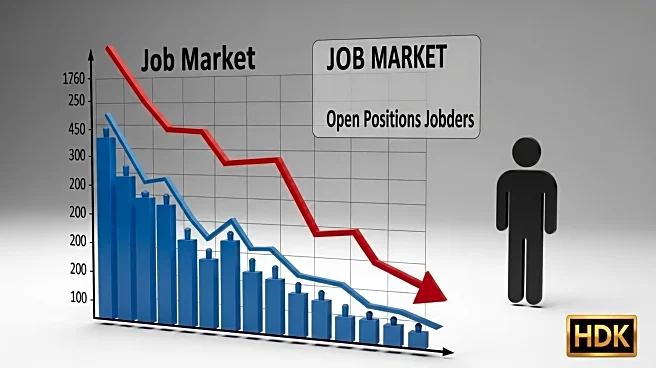What is the story about?
What's Happening?
The U.S. labor market is experiencing a significant downturn, as evidenced by the latest Job Openings and Labor Turnover Survey (JOLTS) data for July 2025. Job openings have fallen to 7.18 million, marking the lowest level since April 2021 and indicating a cooling labor market. This decline is the first in over four years where job openings are fewer than unemployed workers, which currently stand at 7.2 million. The contraction in job openings is particularly notable in sectors such as healthcare, social assistance, construction, and leisure. The Federal Reserve is now facing a delicate balancing act, with markets pricing in an 89% probability of a September rate cut. Chair Jerome Powell has acknowledged the challenges posed by slowing demand and supply-side constraints, suggesting that further deterioration in hiring or wage growth could accelerate policy easing.
Why It's Important?
The cooling labor market has significant implications for equity valuations, consumer spending, and Federal Reserve policy. Defensive sectors and cash positions are emerging as tactical advantages in a potential economic downturn. The labor market's fragility has shifted the policy narrative towards potential rate cuts, which could temporarily buoy equities by lowering borrowing costs and supporting valuations. However, the efficacy of such measures depends on broader economic conditions. Gold prices have surged to record highs as a hedge against political and economic uncertainties, reflecting market skepticism about the Fed's ability to navigate a soft landing. Investors are recalibrating portfolios to prioritize resilience over growth, with defensive sectors such as consumer staples and healthcare outperforming cyclicals.
What's Next?
Investors must monitor the upcoming August jobs report, expected to show modest job gains and a stable unemployment rate of 4.2%. Downward revisions to recent payroll data and persistent hiring inertia could reignite recession fears, prompting further sectoral reallocation. Defensive strategies, such as overweighting healthcare, utilities, and cash, remain prudent, while underweighting cyclical sectors aligns with the current macroeconomic backdrop. The Federal Reserve's policy pivot offers some relief, but the path to a soft landing remains uncertain.
AI Generated Content
Do you find this article useful?















